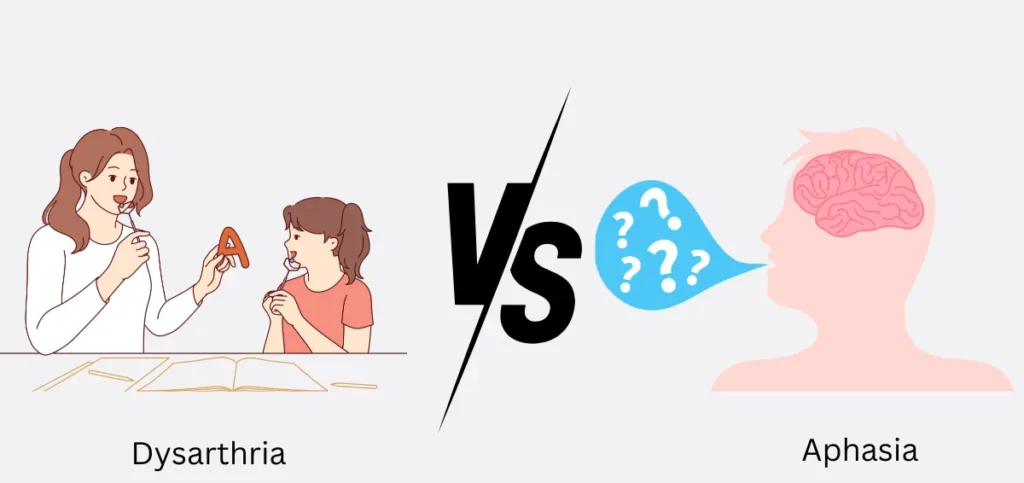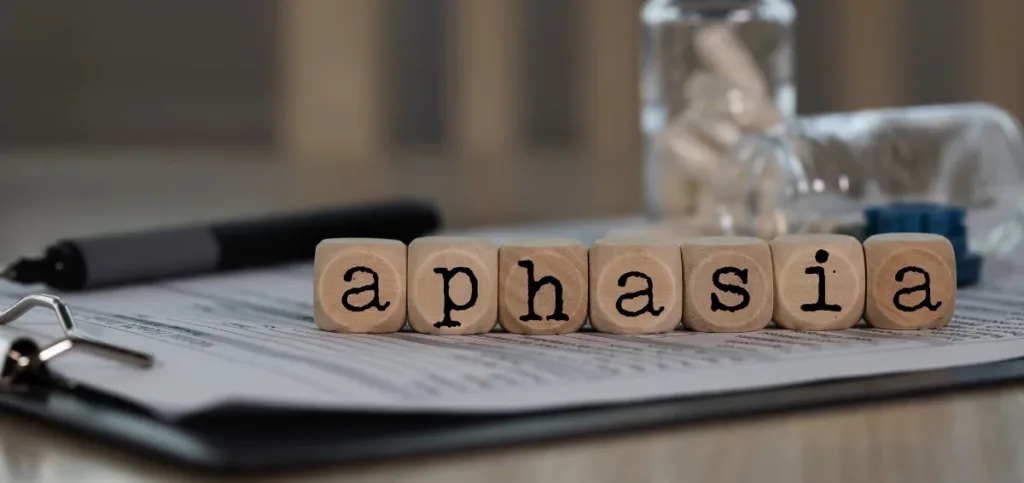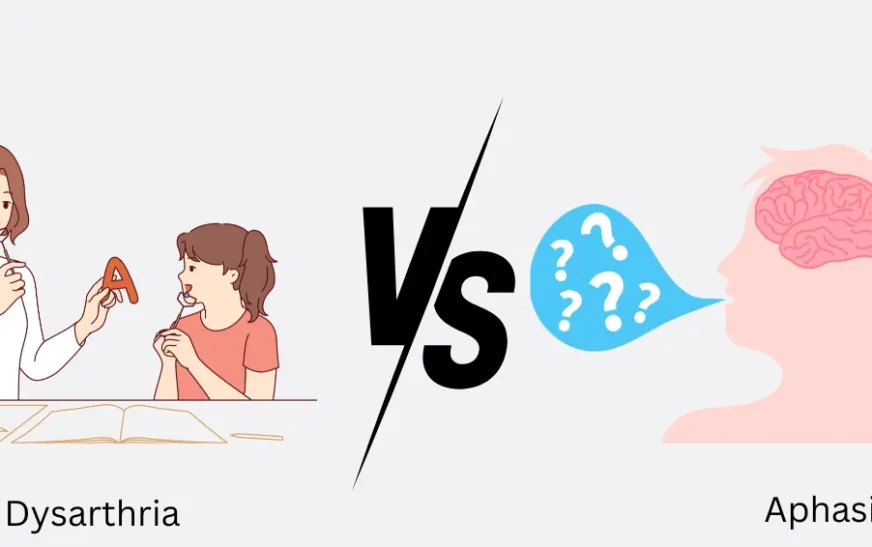
Dysarthria and Aphasia are two speech and language disorders affecting adults. It impacts their understanding of language and speaking. Since both of them deal with communication, it’s common to confuse one with another.
Dysarthria occurs when muscles used for speaking become impaired because of nervous system damage. On the other hand, aphasia impairs someone’s ability to speak, read, write, or understand language due to damage to the brain parts that control language functions.
Let’s find out about these speech disorders.
Read Also: Interpersonal vs Intrapersonal Communication
What is Dysarthria?

Dysarthria is a motor speech disorder. Patients find it challenging to form and pronounce words. It occurs due to an injury to your nervous system that prevents you from fully controlling parts of your body that control speech. Patients don’t have control over their tongue, voice box (larynx), and jaw. They experience difficulty in speaking and making themselves understood by the other person. Note that patients with dysarthria understand language and know what they want to say and how to say it. However, since their muscles are impaired, they find it difficult to speak.
Dysarthria can be developmental or acquired:
- Developmental dysarthria occurs during fetal development or at birth due to brain damage.
- Acquired dysarthria occurs later in life because of an event, such as a stroke or a brain tumor that causes brain damage.
Types of Dysarthria
There are six categories of dysarthria grouped based on the specific part of the nervous system that is affected. There are six types of dysarthria.
- Flaccid dysarthria: It results from injury to the lower motor neurons. People with flaccid dysarthria have breathy and nasal-sounding speaking.
- Spastic dysarthria: It occurs due to damage to the upper neurons on either or both sides of the brain. Those with spastic dysarthria have a strained or harsh-sounding speaking.
- Ataxic dysarthria: When your brain’s cerebellum is damaged, it causes ataxic dysarthria. People with this disorder have trouble pronouncing vowels and consonants and are unable to place emphasis on the right parts of a word while speaking.
- Hypokinetic dysarthria: Hypokinetic dysarthria results from injury to the basal ganglia, which is a structure inside your brain that helps you move your muscles. People with this disorder have slow or rigid-sounding speech.
- Hyperkinetic dysarthria: It results from damage to your basal ganglia. Those with hyperkinetic dysarthria have fast (“hyper”) sounding and generally unpredictable speech.
- Mixed dysarthria: This includes a mix of two or more of the types of dysarthria mentioned above.
What is Aphasia?

Aphasia is an impairment of language and affects the production or understanding of speech and the ability to read or write. Aphasia occurs due to brain injury, most commonly from a stroke. It is prevalent in the elderly. Brain damage resulting in aphasia may also occur from head trauma, brain tumors, or infections.
Aphasia can vary in intensity. If it is serious, the patient is unable to communicate at all. , or mild. It can either impact a single aspect of language use, such as the ability to recall the names of objects, form sentences, or read. But Aphasia can also (and more commonly) affect multiple aspects of communication.
Types of Aphasia
There are several types of Aphasia. They are explained below.
- Global aphasia: It’s a serious form of aphasia. Patients can only produce a few recognizable words and are mostly unable to understand spoken language. They also cannot read or write.
- Broca’s aphasia (‘non-fluent aphasia’): People with Broca’s aphasia can only make short utterances of less than four words. These people may understand speech relatively well and can read but are limited in writing. It is called ‘non-fluent aphasia’ because of the halting way in which the person speaks.
- Mixed nonfluent aphasia: Patients with mixed nonfluent aphasia have sparse and effortful speech and are also limited in their understanding of speech. They cannot read or write beyond an elementary level.
- Wernicke’s aphasia (‘fluent aphasia’): Wernicke’s aphasia impacts a person’s ability to understand the meaning of spoken words. Their ability to produce connected speech isn’t affected so it is also called a ‘fluent aphasia.’ But it doesn’t mean that patients have normal speech is far from normal. They cannot make proper sentences and cannot speak in a flow. Reading and writing are commonly impaired.
- Anomic aphasia: People with anomic aphasia experience a persistent inability to supply the words for what they want to talk about- particularly nouns and verbs. So, their speech is grammatically correct but full of vague circumlocutions and expressions of frustration. They comprehend speech well and can typically read. But they cannot find the right words while writing or speaking.
- Primary Progressive Aphasia: Primary Progressive Aphasia (PPA): PPA is a neurological syndrome in which language capabilities become impaired slowly and progressively. PPA results from neurodegenerative diseases, such as Alzheimer’s Disease or Frontotemporal Lobar Degeneration. PPA occurs from damage to the brain tissue responsible for speech and language. After problems with speech, patients start experiencing memory loss at a later stage.
Read Also: Brainspotting vs EMDR
Key Differences between Dysarthria and Aphasia
Both dysarthria and aphasia are communication disorders. Both of them impair a person’s ability to speak. However, there are certain key differences between them. They include the following:
- Dysarthria is a motor disorder. On the other hand, Aphasia is a language disorder.
- Dysarthria results from damage to motor nerves, but Aphasia occurs due to damage or injury to parts of the brain.
- Someone with dysarthria experiences difficulty speaking. A person with Aphasia has trouble understanding others and expressing themselves.
- One can have dysarthria without aphasia. Dysarthria only affects the muscles that control speech. It does not affect the brain’s language centers. A person with dysarthria may be able to fully understand language. However, their ability to communicate verbally is impaired because of problems in controlling the movements of their mouth, tongue, or vocal cords.
- Despite these differences, it is possible for someone to have both aphasia and dysarthria. It is known as a mixed receptive-expressive language disorder.
Summing Up
Both Dysarthria and Aphasia can make daily life challenging. It is critical to have a full understanding of one’s condition and provide access to tailored therapy. If you or your loved one is experiencing any of these speech disorders, seek help from a professional and work toward improving their condition.










